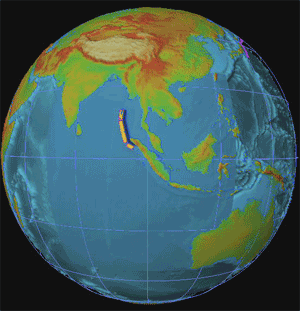
Most earthquakes, like these, are relatively harmless. After my second, I was informed of the "Safeway Rule," which is, to those on the east coast, if the quake's national television coverage is comprised of images of cans in the aisles of grocery stores, fear not, as that is the extent of catastrophe.
Other earthquakes, however, can be disastrous. The deadliest on record was in 1556 in Shansi, China, which killed approximately 830,000 people. The Great Sumatra-Andaman earthquake in 2004 had a magnitude of 9.3, lasted 8-10 minutes, triggered other quakes all the way to Alaska, and moved the entire planet 1 centimeter (no small feat!). The resulting tsunamis killed more than 225,000 people around the Indian Ocean. The most recent shaker, in Sichaun Province, China, was an 8.3 on the Moment magnitude scale, and as of June 8, has left about 70,000 dead, 18,000 missing, and almost 375,000 injured.

The Great Sumatra-Andaman Earthquake
These tremors are devastating, and can kill hundreds of thousands of people, in addition to costing countless sums of money in damage. So what can we, as the highly intelligent species that we are, do to gain some kind of warning? Anecdotal stories of chickens or dogs going crazy and goldfish jumping out of tanks may not be reliable indicators. Our seismographs, though they be essential to the measurement of size, can only give us maybe a minute's warning, and often give false results. Surely, we can do better.
It turns out we may be able to, from space.
When the Earth was formed 6000 years ago, water molecules were churned into and captured within the rock, which was then subjected to extreme heat and pressure. This broke apart the water molecules, forming byproducts such as oxygen and hydrogen, but also crystals within the rock that conduct electricity. In the early stages of an earthquake (weeks before we feel them), increased pressure at the point of interaction causes changes in the chemical properties of these crystals, changing the electrical field surrounding them. Electric fields create magnetic fields, and this electrical field generated has such magnitude that a large magnetic field and a slight infrared (IR) glow radiate out from the Earth at the epicenter of the coming quake.

Imaging the ionosphere
Scientists have been able to detect large changes in magnetometer readings in the weeks and days leading up to a major quake, such as the one in 1989 that shook the SF bay area. However, the magnetic field also sucks in negative ions from the ionosphere, essentially creating a dimple in the atmosphere, up to 12 miles deep. This also affects communications between satellites and radio towers. Using special satellites that measure IR signatures while communicating with GPS satellites, we can detect these heat signatures and dimples, up to two weeks before a major tremor.
How do we know all this? In 1960 and 1964 in Chile and Alaska, respectively, changes in the ionosphere created radio interference in the days before major earthquakes. Prior to a cluster of quakes in Japan in the late 1960's, people reported seeing eerie lights in the sky, which could have resulted from ion movement. In 1989, after the Loma Prieta earthquake, researchers went back and examined magnetometer readings leading up to the earthquake, and found that two weeks prior, the local magnetic field began increasing, peaking at 60 times normal three hours before the tremor, and persisted in the weeks after.

Epicenter of the Sichuan Quake
The most recent evidence, however, comes from the disaster in China: on May 2, a scientist working for NASA at George Mason University noticed the telltale IR signature and changes in the ionosphere above the Sichuan Province. He sent a memo to some of his colleagues, which was only leaked to the public.
Ten days later, The Great Sichuan Earthquake, magnitude 8.3, killed 70,000 people.
Should they have gotten the memo?
Paddy
Sources:
http://news.cnet.com/Bright-lights,-big-quake/2100-11395_3-6061448.html
http://dsc.discovery.com/news/2008/06/10/earthquake-satellite.html
http://www.sunearthplan.net/5/25/3D-movies-of-the-ionosphere
Wikipedia
No comments:
Post a Comment